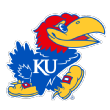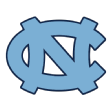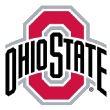It has been a rocky year for the blue bloods. And it could get worse in March.
There's still some basketball to be played, and the difficulty of each team's path will crystallize on Selection Sunday, but right now, according to our Giant Killers model, the No. 1 and No. 2 seeds most vulnerable in the second round are Kansas and North Carolina. That's based on Kansas' (No. 1 seed) chance to defeat each of the No. 8 or No. 9 seeds in the latest Bracketology and UNC's (No. 2 seed) chance against the No. 7 or No. 10 seeds.
After diving into the most dangerous Giant Killers a week ago, today we're examining tenuous Giants. Who is in danger of suffering a major upset early? Let's identify one possibility from each seed line.

No. 1 Kansas Jayhawks
Even though BPI rates Xavier as the worst No. 1 seed by a decent margin, the current batch of second-round opponents for the top seeds are, overall, a worse matchup for Kansas.
The Jayhawks, who rank seventh overall in BPI, have three major weaknesses: depth, rebounding and Udoka Azubuike's free throw shooting. The bench plays just 20.1 percent of minutes available, the fourth-lowest rate in Division I, per KenPom. Although that is not explicitly a factor in either BPI or our Giant Killers model, it does suggest that the Jayhawks are permanently on thin ice with their bigs. Azubuike's free throw shooting -- on consecutive attempts Monday vs. Texas, he hit the backboard and then air-balled short -- certainly could force the star big man to the bench at times in late, close-game situations. And their struggles on the boards makes the Jayhawks susceptible to matchup problems against certain types of teams. Missouri, Kansas' worst-case scenario among current No. 8 and No. 9 seeds, barely has a positive GK Factor over the Jayhawks but rebounding is the reason it is positive at all. Missouri would have a 26 percent chance to beat Kansas on a neutral court, while Kansas averages an 81 percent chance to win against the entire current group of possible second-round opponents.

No. 2 North Carolina Tar Heels
Led by Luke Maye down low, North Carolina is a constant threat to opponents on the offensive glass. That's no surprise, given the Tar Heels' style over the years, but this is not quite the same caliber team as last year's national champions. Most notably, this year's team struggles to defend the 3-point shot, as opponents score 41 percent of their points against UNC from deep (fifth-highest in the nation) at a shooting clip of 38.7 percent.
Seven of the eight current No. 7 or No. 10 teams would have at least a 20 percent chance to beat North Carolina, per our Giant Killers model (Kansas State, at 16 percent, is the exception). The worst matchup for UNC would be Saint Mary's (North Carolina would have a 66 percent chance to win). That's mostly due to the Gaels' overall BPI strength, though the WCC school's superior 3-point shooting gives them a minor GK factor boost (plus-1 percent). While UNC might be hoping for an easier second-round matchup, Jock Landale vs. Maye would be interesting to watch.

No. 3 Tennessee Volunteers
The Volunteers have posted the 44th-best raw defensive efficiency this season, but after adjusting for opponent, that improves to fourth, ahead of teams such as Texas and Michigan State.
Offensively the Volunteers are relatively efficient at knocking down 3-pointers, but they attempt them on only 35.5 percent of their overall field goal attempts, 230th in Division I, per KenPom. Inside the arc is where most of their shots come from and where they struggle efficiency-wise. If the Volunteers go far in the tournament, it could be on the back of Grant Williams, their opponent-adjusted win shares leader. Williams attempts post-ups often -- 7.7 times per game, the ninth-highest rate in Division I, per Synergy Sports -- converting them for .93 points per possession, slightly better than Tennessee's overall half-court offense.
All of the No. 3 seeds are in decent shape against the current crop of No. 14 seeds, but the Volunteers are the most vulnerable of the lot and would be best to avoid Northern Kentucky. Thanks in part to an advantage in the aforementioned field goals, the Norse would have a 23 percent chance to upend Tennessee.

No. 4 Ohio State Buckeyes
Keita Bates-Diop's explosion this season has transformed Ohio State from an unremarkable team to a possible top-four seed in the NCAA tournament. The future first-rounder is the key cog in the Buckeyes' defensive efforts and will often lock down an opposing wing with his 7-foot-3 wingspan. With help from teammates such as Jae'Sean Tate, Ohio State has the 14th-most efficient opponent-adjusted defense in Division I.
But despite the best efforts of Bates-Diop, the Buckeyes aren't perfect. At times, their 3-point shooting is absent and their free throw shooting is mediocre. Point guard C.J. Jackson's 3-point shooting has improved over last season, but he has no reliable backup.
Among the No. 13 seeds, OSU's worst-case scenario is to face Vermont, as the Buckeyes would have an only 65 percent shot to win that matchup on a neutral court, thanks in large part to the Catamounts' significant edge from 3.
Note: This was very close between Ohio State and Arizona. But John Gasaway highlighted Arizona's problems here -- and that was before scandal rocked the NCAA and the Wildcats.

No. 5 Rhode Island Rams
Between us mentioning the Rams as an ideal matchup for a couple of Giant Killers last week and their 30-point home loss to Saint Joseph's on Tuesday, their inclusion here is probably no surprise. Although all of the aforementioned teams have weaknesses that make them beatable, the Rams have quite a few possible first-round opponents against which they wouldn't even be favored. Among the five current No. 11 seeds, our Giant Killers model would make Rhode Island underdogs to Louisiana (40 percent), USC (47 percent) and Baylor (48 percent). That isn't exactly the way a No. 5 seed wants to start the tournament.
Where the Rams perform well is in the turnover battle. They have strong ball security and, likely in part due to pressing on 19 percent of possessions, per Synergy Sports, boast the third-best defensive turnover rate in Division I.
All those extra possessions are necessary because Rhode Island's problem is that it just doesn't shoot well enough from the field and isn't a great rebounding team, either. All of that results in a GK Factor of at least plus-6 percent for four of the five current No. 11 seeds and a whopping plus-22 percent for Louisiana.
